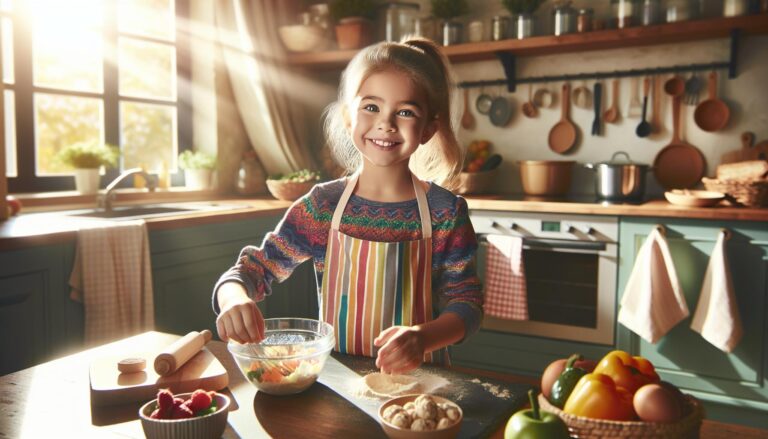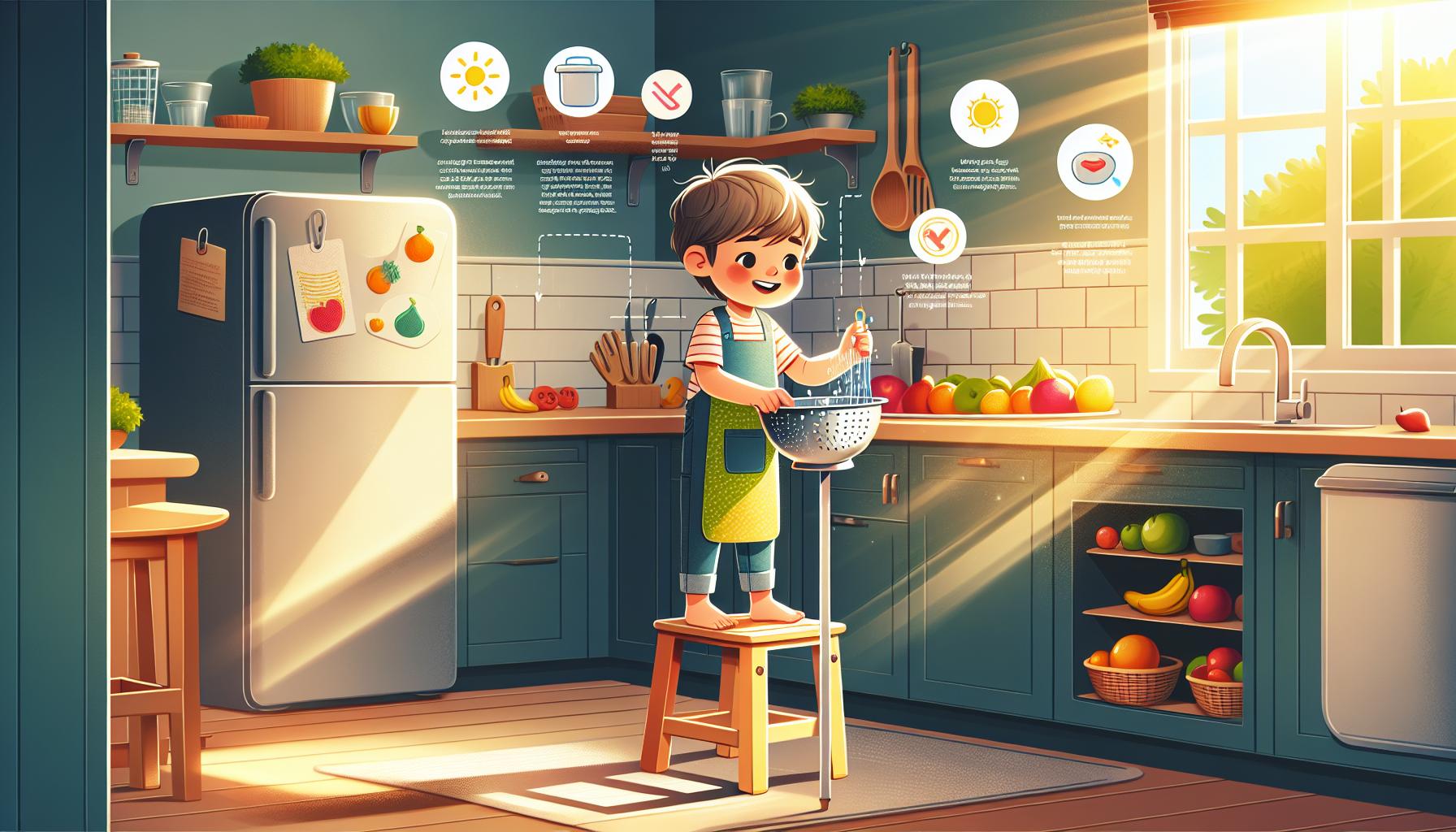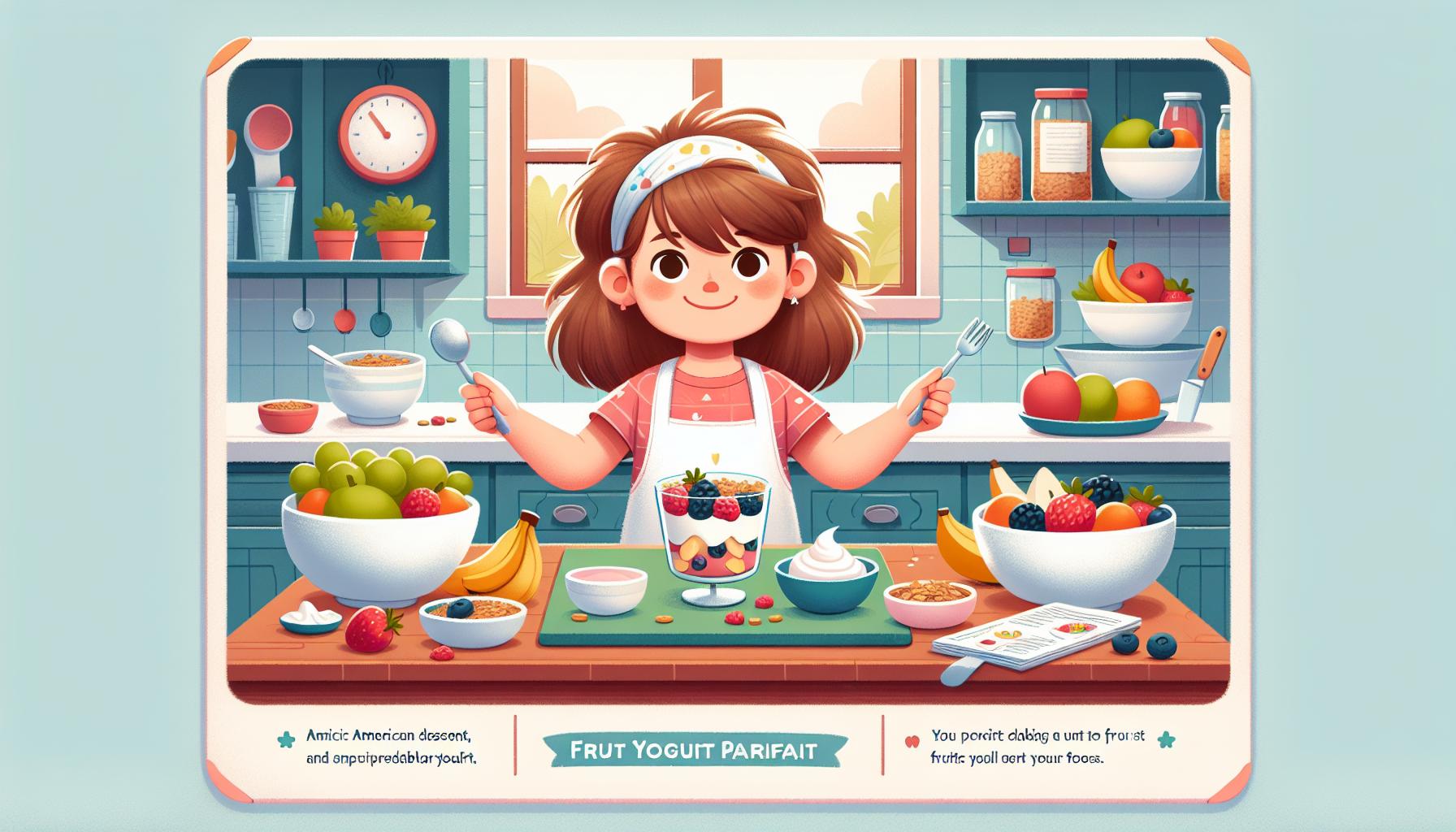
Teaching kids to cook goes beyond creating tasty meals – it’s about building life skills and confidence that’ll last a lifetime. We know that helping children feel comfortable in the kitchen can seem challenging at first but the rewards are incredible. By starting early we can help young chefs develop healthy eating habits while having fun.
Getting kids excited about cooking isn’t just about following recipes. We’ve found that when children learn kitchen basics they develop math skills problem-solving abilities and creativity. Plus what’s better than watching their faces light up with pride when they serve their first homemade dish to family members? Whether your child shows interest in baking cookies or making simple sandwiches there’s always a perfect starting point.
How do we make the kitchen a safe welcoming space for young cooks? What activities will spark their interest in cooking? Let’s explore practical ways to boost your child’s cooking confidence and create lasting memories together in the kitchen.
Key Takeaways
- Children develop essential life skills like decision-making, problem-solving, and time management through cooking activities
- Age-appropriate tasks, from simple mixing for preschoolers to independent meal preparation for pre-teens, help build cooking confidence gradually
- Kitchen safety fundamentals, including proper tool handling and age-specific guidelines, create a secure environment for young chefs to learn
- Starting with no-cook recipes before progressing to supervised stovetop cooking helps establish a strong foundation in culinary skills
- Regular cooking practice combined with positive reinforcement and celebration of achievements helps transform initial hesitation into lasting kitchen confidence
- Making cooking fun through creative food presentation and hands-on learning activities encourages children to develop a lifelong interest in culinary skills
Why Teaching Kids to Cook Builds Confidence
Teaching kids to cook creates a strong foundation for independence in the kitchen. Kids develop mastery over basic tasks like measuring ingredients, following recipes and using kitchen tools safely. Each successful dish boosts their self-esteem and encourages them to try new challenges.
The kitchen provides a perfect environment for hands-on learning and skill development:
- Decision Making: Kids learn to select ingredients, plan meals and make choices about flavor combinations
- Problem Solving: Understanding recipe adjustments, substitutions and kitchen mishap solutions strengthens critical thinking
- Time Management: Following recipe steps and coordinating multiple tasks improves organizational abilities
- Safety Awareness: Learning proper knife handling, stove safety and kitchen cleanliness builds responsibility
Cooking activities match different age groups and skill levels:
| Age Group | Appropriate Tasks | Confidence Building Benefits |
|---|---|---|
| 3-5 years | Mixing, pouring, washing produce | Motor skills development, task completion |
| 6-8 years | Measuring, simple knife work, reading recipes | Math skills, following instructions |
| 9-12 years | Basic cooking, baking, meal planning | Independence, creativity |
Children gain pride through sharing their culinary creations with others. Making a sandwich for lunch or baking cookies for family creates meaningful connections between effort and appreciation. This positive reinforcement motivates kids to expand their cooking abilities.
The kitchen also offers opportunities for cultural exploration and creativity:
- Experimenting with global recipes expands food knowledge
- Creating original recipe variations encourages innovation
- Cooking family heritage dishes preserves traditions
- Adapting recipes builds flexible thinking skills
Regular cooking practice transforms initial hesitation into kitchen confidence. Kids move from basic tasks to complex recipes at their own pace, celebrating small victories along the way.
Essential Kitchen Safety Rules for Children

Teaching kitchen safety establishes lifelong habits that protect children while they explore cooking. Creating a safe cooking environment empowers kids to develop confidence in their culinary skills.
Age-Appropriate Kitchen Tasks
Children’s kitchen activities align with their developmental stages for optimal safety:
Ages 3-5:
- Washing fruits vegetables in a colander
- Mixing dry ingredients with a wooden spoon
- Adding pre-measured ingredients to bowls
- Helping to set timers
- Using cookie cutters with supervision
Ages 6-8:
- Measuring dry ingredients with cups spoons
- Cracking eggs into a separate bowl
- Greasing baking pans
- Using a butter knife to spread toppings
- Rolling dough with a rolling pin
Ages 9-12:
- Using a vegetable peeler
- Operating a hand mixer
- Following basic recipes independently
- Using a microwave with proper instructions
- Making simple sandwiches salads
Safe Kitchen Tool Handling
Kitchen tool safety creates confident young cooks:
Basic Safety Rules:
- Keep handles turned inward on stovetops
- Use oven mitts for hot surfaces containers
- Clean spills immediately to prevent slips
- Maintain a clear workspace
- Store sharp tools in designated areas
- Start with child-safe knives plastic serrated edges
- Practice proper grip techniques on utensils
- Use non-slip cutting boards
- Select appropriately sized tools for small hands
- Keep electrical appliances away from water
- Step stools with non-slip surfaces
- Child-sized aprons to protect clothing
- Heat-resistant gloves for older kids
- First aid kit in an accessible location
- Fire extinguisher mounted at child height
Starting With Basic Cooking Skills

Building cooking confidence starts with mastering simple recipes that kids can prepare safely. Starting with basic skills creates a strong foundation for more advanced techniques while celebrating early successes.
Simple No-Cook Recipes
No-cook recipes offer perfect entry points for young chefs to develop kitchen confidence. Kids can create tasty snacks like fruit yogurt parfaits layered with granola or colorful veggie wraps with cream cheese spreads. Here’s a structured approach to no-cook preparation:
- Assembling ingredients
- Gather all items before starting
- Practice proper measuring techniques
- Learn food group identification
- Basic food prep skills
- Spreading butter or cream cheese
- Peeling bananas oranges
- Mixing dry ingredients
- Food presentation
- Arranging ingredients in patterns
- Creating fun shapes with cookie cutters
- Decorating plates with edible elements
Easy Stovetop Recipes
After mastering no-cook recipes, kids can progress to supervised stovetop cooking. These recipes introduce heat safety while maintaining creativity in the kitchen.
- Beginner stovetop dishes
- Scrambled eggs with cheese
- Grilled cheese sandwiches
- Simple pancakes from scratch
- Safety practices
- Setting burners to medium heat
- Using pot holders consistently
- Keeping handles turned inward
- Essential techniques
- Stirring without splashing
- Flipping foods safely
- Testing food doneness
| Age Group | Recommended Stovetop Tasks | Adult Supervision Level |
|---|---|---|
| 8-10 years | Stirring ingredients | Constant |
| 11-12 years | Flipping pancakes | Direct |
| 13+ years | Complete recipe execution | Nearby |
Making Kitchen Time Fun and Educational
The kitchen transforms into an exciting classroom where kids learn vital skills through hands-on activities. Creating an engaging atmosphere helps children develop a lifelong love for cooking while mastering essential life skills.
Measuring and Math Skills
Kids practice real-world math through measuring ingredients with cups, spoons, and kitchen scales. Doubling recipes reinforces multiplication skills, while halving them teaches fractions in a practical way. Simple tasks like counting eggs or timing baking sessions strengthen number recognition and basic arithmetic:
- Converting measurements (cups to tablespoons)
- Adding ingredient quantities
- Dividing portions into serving sizes
- Reading temperature settings
- Understanding cooking times
Creative Food Presentation
Food presentation turns cooking into an artistic expression where children explore colors, shapes and textures. Here’s how kids can develop their creative skills through food styling:
- Arranging fruit slices in rainbow patterns
- Creating faces on sandwiches using vegetables
- Cutting cookies into geometric shapes
- Building themed lunch plates (beach scenes, animal faces)
- Decorating cupcakes with different piping techniques
A dedicated presentation station with child-safe tools encourages experimentation:
| Tool | Creative Use |
|---|---|
| Cookie cutters | Shape sandwiches and fruits |
| Piping bags | Decorate baked goods |
| Molds | Form rice or vegetables |
| Garnish tools | Create vegetable flowers |
- Start with a clean plate
- Add main ingredients in the center
- Place colorful elements around the edges
- Add garnishes for height variation
- Wipe plate edges before serving
Building Independence Through Meal Planning
Meal planning empowers kids to take control of their food choices while developing organizational skills. This essential step in cooking confidence teaches children about balanced nutrition balanced nutrition practical budgeting.
Shopping List Creation
Creating shopping lists helps kids understand kitchen organization and meal preparation. Here’s how to make list-making engaging for children:
- Set up a magnetic notepad on the fridge for kids to jot down needed items
- Create categorized lists (fruits vegetables proteins grains) with colorful markers
- Take photos of empty containers or packaging to remember exact products
- Use a simple checklist template with pictures for younger children
- Practice counting estimating quantities for recipe ingredients
Shopping together reinforces list-making skills by:
- Finding items in store sections
- Comparing prices for budget awareness
- Selecting fresh produce
- Reading nutrition labels
- Checking items off the list
Simple Menu Development
Kids learn to plan balanced meals through interactive menu creation. Start with these basic steps:
- Choose one protein one vegetable one grain for each meal
- Create a weekly calendar with breakfast lunch dinner spaces
- Draw or paste pictures of planned meals
- Mark dishes they can prepare independently
- Include family favorites new recipes to try
Menu planning activities include:
- Rating previous meals with star stickers
- Picking seasonal ingredients
- Planning portions for family members
- Creating theme nights (Taco Tuesday Pizza Friday)
- Building grocery lists from chosen menus
- Track meal preparations
- Monitor grocery needs
- Share meal responsibilities
- Feel proud of their contributions
- Practice time management skills
Celebrating Kitchen Success
Positive reinforcement transforms kids’ culinary experiences into confidence-building moments. Here’s how to create an environment that celebrates every kitchen achievement:
Creating a Reward System
A simple star chart tracks cooking accomplishments, from mastering basic skills to completing full recipes. Children earn recognition for:
- Following safety rules consistently
- Learning new techniques like whisking or measuring
- Completing recipe steps independently
- Keeping their workspace clean
- Helping with meal planning tasks
Documenting Progress
Photography captures kids’ culinary journey in meaningful ways:
- Taking before-and-after photos of dishes
- Creating a digital recipe portfolio
- Recording video tutorials of mastered skills
- Sharing achievements on family social media
- Making a cooking scrapbook with recipe notes
Sharing Culinary Creations
Kids gain confidence by sharing their kitchen accomplishments:
- Hosting mini cooking demonstrations for family
- Planning special family dinners
- Teaching siblings simple recipes
- Packaging homemade treats for friends
- Contributing dishes to family gatherings
Recognition Opportunities
Small acknowledgments boost children’s kitchen confidence:
- Displaying recipe cards they’ve mastered
- Creating a “Chef of the Week” spotlight
- Adding their signature dishes to regular meal rotations
- Giving them personalized cooking tools
- Naming recipes after their creators
What special dish would your child love to master? How can you help them showcase their growing kitchen skills to family and friends?
Remember, recognition doesn’t need to be elaborate – a simple high-five or displaying their creation prominently at mealtime reinforces their accomplishments and encourages continued learning in the kitchen.
Conclusion
Teaching kids to cook is one of the most rewarding investments we can make in their future. When we empower children with kitchen skills we’re not just helping them create delicious meals – we’re building their confidence self-reliance and creativity.
By starting with simple tasks and gradually introducing more complex techniques we’ll see our young chefs grow into capable confident cooks. The kitchen becomes a place where math science and creativity come together to create not just meals but lasting memories.
Remember that every spill stir and success is a stepping stone in their culinary journey. Let’s celebrate their achievements and watch as they develop skills that will serve them throughout their lives.
Frequently Asked Questions
What age should children start learning to cook?
Children can start learning cooking skills as early as age 3-5 with simple tasks like washing vegetables and mixing dry ingredients. As they grow older, they can gradually take on more complex tasks. The key is to match activities with their developmental stage and ensure proper supervision.
How can cooking help develop math skills in children?
Cooking naturally incorporates math through measuring ingredients, following recipes, and adjusting portion sizes. Children practice fractions, multiplication, and division while measuring cups, tablespoons, and ingredients, making math practical and engaging.
What are some safe starter recipes for kids?
No-cook recipes are ideal for beginners, such as fruit yogurt parfaits, veggie wraps, and simple sandwiches. As children gain confidence, they can progress to supervised stovetop cooking with dishes like scrambled eggs and grilled cheese sandwiches.
How can parents ensure kitchen safety for young cooks?
Create a safe environment by using child-safe tools, providing proper supervision, teaching basic safety rules, and equipping the kitchen with safety measures like step stools and non-slip cutting boards. Always demonstrate proper technique before allowing children to try tasks independently.
What are some ways to make cooking fun for kids?
Turn cooking into an adventure by creating themed meals, letting kids experiment with food presentation, organizing cooking challenges, and celebrating their achievements. Make it interactive by involving them in meal planning and grocery shopping.
How can cooking build a child’s confidence?
Cooking builds confidence through mastering new skills, completing recipes successfully, and receiving recognition for their efforts. Start with simple tasks and gradually increase complexity, celebrating each achievement along the way.
What role should parents play while teaching kids to cook?
Parents should act as guides, demonstrating techniques, supervising safety, and offering encouragement. Allow children to take the lead when ready, but remain available for support and guidance while maintaining a positive, patient learning environment.
How can meal planning involve children in cooking?
Involve kids in creating shopping lists, planning balanced meals, and organizing ingredients. This teaches responsibility, nutrition awareness, and organizational skills while making them feel more invested in the cooking process.

